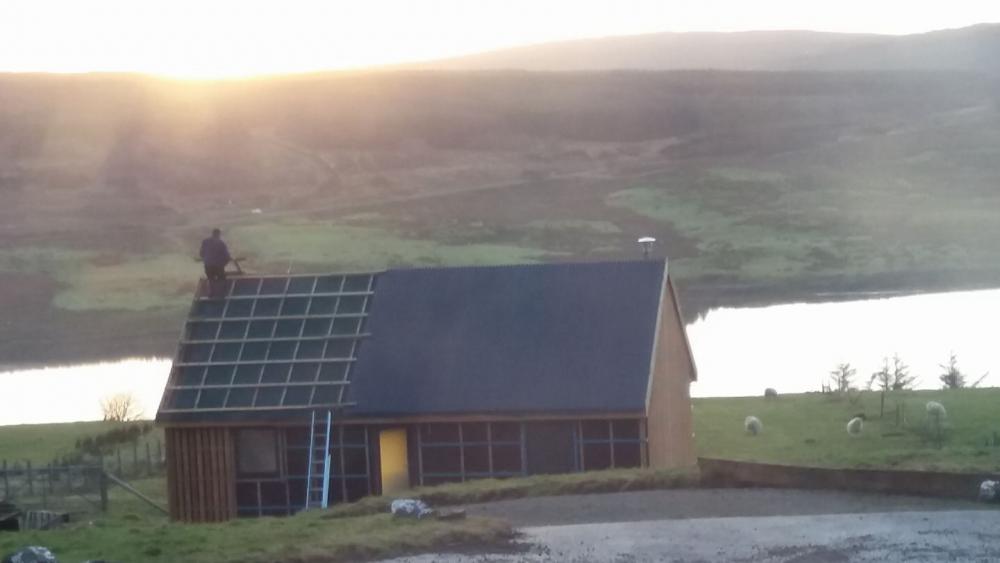Leaderboard
Popular Content
Showing content with the highest reputation on 02/07/17 in all areas
-
3 points
-
2 points
-
I had similar on my last place... Red brick house to blue bricks, render, and cladding 3 windows to patio doors 3 velux windows added and all under non material amendment2 points
-
I know what @TerryE means here ..!! I applied for NMA, and got away with : - remove one dormer, replace 2 large velux - replace French doors with chimney and windows - add 4 new velux windows - move 3 large dormers back into the roof - effectively changing the frontage of the house - add an ASHP All of this was under a single NMA and went through with one conversation with a planner. Mate down the road wanted to change two sets of patio doors to a single bifold and was told to reapply as it wasn't non material ...!2 points
-
With the insulation values you are working to you have to consider that the heating may hardly ever be on. My wife is insistent on having UFH so that the tiles are warm. But the reality is the heating will hardly ever be on so they won't benefit from it. I may have to run the heating in the ensuite at a higher temperature than the rest of the house just to warm the tiles. If you use electric UFH in just the bathrooms you have the option of warming the tiles even if the heating isn't on whilst also saving all the other expenses. Then you could go for radiators in the other upstairs rooms, although I would guess that heat rising from downstairs means that you don't need any upstairs heating. This depends on the U-valeus of your floors and windows, whether you have MVHR etc, but 0.11 U-vlaue walls suggest you will need very little heating.1 point
-
You don't need to have pozi joists to fit UFH Just fit aluminium spreader plates and notch the top of each joist accordingly. If you don't want to notch out the full 16mm, just notch 6mm of the joist and fix 12mm ply atop the joists. Bingo.1 point
-
unfortunately not, and it may be a very important point, hopefully she ordered it direct as it will be a stronger bargaining chip. Ill ask in the morning. Its a bit late for me to pester her about details now. It won't change anything until then anyway1 point
-
I'm also trying to solve this same dilemma. Part of it depends on what is driving your underfloor heating on the ground floor. If you are running a heat pump then it seems a shame after the big up-front cost of installing it, to then use a less efficient system upstairs. If you're not having UFH upstairs, the insulation between floors may be working against you by preventing heat transfer to the upper floors.1 point
-
We did, stuff the Brownie points. And (sod it he beat me to it), I'm copying @PeterW1 point
-
I don't understand the need for the extra wall plates? Our present house has UFH upstairs on conventional solid joists. 9mm OSB to support UFH pipes, 25 by 50mm battens then whatever floor you were going to have anyway. Nothing complicated or particularly expensive at all. And yes why so much insulation between floors? Less insulation and the saving more than pas for the extra floor make up.1 point
-
As I thought, he's gone the full amendment route. A good way to pre-empt any concerns from the planners is to have a word with your neighbour, and get him to write a letter of support which you can include with the application. With a full application, he's going to be consulted anyway, so being proactive will probably go down well.1 point
-
Tell them your going to pour petrol all over it and set it alight. When they say "how will that affect us, sir?", you simply reply.... "directly you twats, cos it'll be in your showroom when I do it". ? Edward Woodward.1 point
-
1 point
-
Yup, I agree with @AliG. I don't think that you'll get way with this as an NMA. Your garage is only 1m from your neighbours boundary, and this amendment will obscure what at the moment is a fairly open sight-line across open gardens and they will lose their view of the setting sun. IMO, the LPA might even treat this as a material amendment. At some point you will need to get your neighbour at No 14 onside. One option might be to trade moving the whole garage to the NE to open up his west facing sight-line to the detriment of his N facing one. I think that you'll need to tread carefully on this one.1 point
-
Say you have a 16mm hole but you wanted really to put a 20mm hole in or you drilled a 20mm hole and wanted a 25mm. Yes, I know cone cutters / step drills etc but they go blunt. Starrett have the "OOPS" allowing holesaws of two DIFFERENT arbor sizes to be used but no good for the smaller sizes: But for using two of the smaller sized arbor cutters together........I think I'll call mine the "FOOKIT". First, get yourself a 1/2" UNF 20tpi x 2 1/2" long bolt and cut the head off, file neatly and de-burr: Then screw on a couple of Starretts: Job done. The one in the picture needed a 13mm chuck you could turn it down to 10mm. I did the above one in 2014. I keep one in my tool bag for electrical work. I call it the "FOOKIT". Then today, needs must and all that, the FOOKIT+: Take one 5/8"-18 UNF bolt. Black would have been better but they gave me BZP and plain nuts: Stick 3 nuts on and bung it in the lathe. Roughly turn down the head end to 10mm dia x 25mm long. Drill and pin the nut onto the shaft (you could of course weld it on): Screw on a big "Starrett": Screw on the small Starrett: Pack between the two with M16 washers if you want the smaller one to project more: Best go and use it for the job I need it for now!1 point
-
With the garage so near to the boundary I would think that it is a material change to your neighbour. This will be particularly true if they objected before due to the garage.1 point
-
The secret here is that if you do have one case officer allocated to your application and keep her or him onside by feeling that you are fully keeping the panning department in the picture and not pulling a fast one then the comfort level is a lot higher and you will get a lot more going through on the nod.1 point
-
Terry's right, foaming would be far better than trying to tape it, as I doubt that ordinary foil insulation tape (it that's what you're thinking of) will stay stuck for long inside a cavity. Low expansion foam, applied with a proper gun, will be a permanent solution for sealing the gaps. The only sort of tape that might stay on long term is the very expensive airtightness tape, like Siga, but that would cost more than a few cans of foam and a decent gun and not do as good a job. It's easy enough to just go around with low expansion foam and do the sealing, as the low expansion stuff both adheres very well and, more importantly, won't carry on expanding and risk moving the insulation.1 point
-
I don't think you need to do this but it was just a thought so I'll write it...... You could swap out one ( or both ) glass panels for a solid panel or a solid panel with a square or strip of glazing to make it look more like a door. That would only cost a few hundred quid.1 point
-
I'd go with whatever made me happy, and let everyone else adapt, or remain quiet whilst they disapprove. . Everyone will soon accept things as the norm, it's just fresh to you right now so the 'issue' seems bigger than it actually is. Stick a doorbell alongside it and call it a day .1 point
-
More reason to leave it for now . Or bite the bullet and crack on with the UVC ASAP ( e.g. now )1 point
-
If you are on the case and working the issue with the builder then that's the main thing IMO. I would have though foam filling would be a safer bet than taping, but if you do tape then you'd need to use a decent tape with a 20 year guaranty or whatever. @JSHarris was the trained chemist, so he's probably got a more informed view here.1 point
-
You are in the lap of the gods because there is no national definition of what constitutes non-materiality. For example we put in an NMA to change the design of our front door (which can't be seen from the public highway). It got rejected because it was a change to the principle elevation. When I pointed out to the planner that my application had explained that the front door wasn't visible from the road, his response was that this didn't matter because callers to the house would notice that the elevation was different to the elevations approved in our application!! So it depends on your LPA but if your garage is in front of the property or this change impacts the site-lines of any neighbours then the planners might still insist on your submitting a minor material amendment. If your LPA allows people to talk to planners the maybe a quick phone call will help resolve the issue, but if they insist on pre-planning advice then perhaps the best route would be just to submit the NMA and talk to the planner once allocated. She or he might then advise you to amend the submission to make it a MMA. (That's assuming that the you can find out who has been allocated as case officer. This is what we planned to do with our NMA, but we only found out the name of the case officer when we received the rejection.)1 point
-
Guys. Slight plea from a Luddite ....... This thread is not in boffins corner, so.....can we have JFLAT's (Just a Few Less Abreviated Terms) Either that or provide a glossary IGMC TFYU HAGE Bar Knee1 point
-
1 point
-
If the self employed builder is your "only" contractor. I.e. He will be employing all other sub-contract trades then he is the main contractor. In that scenario you would normally have a contract. If however, you are employing various trades then you are the contractor and will need to register for CIS as your accountant has advised. Or put another way; if the ONLY invoice your limited company is going to receive is from your builder as "main contractor" then you do not need to worry about CIS (but he certainly does!). Or if you will have multiple invoices from various "sub contractors" then you are the "main contractor" and have to use CIS. however, even if you are not a "construction" company. if your turnover on "construction" related services is in excess of £1m you still have to register for CIS. Overview of CIS: https://www.gov.uk/what-is-the-construction-industry-scheme As a Contractor: https://www.gov.uk/what-you-must-do-as-a-cis-contractor As a Sub Contractor: https://www.gov.uk/what-you-must-do-as-a-cis-subcontractor Just to really confuse matters you can register for gross payment status as a subcontractor, subject to certain conditions: https://www.gov.uk/what-you-must-do-as-a-cis-subcontractor/gross-payment-status1 point
-
The answer is simple, Like @ProDave I am CIS registered, and I am a Ltd company, If I do a one off job for a private person then they simply pay my invoiced amount, the fact you are building as a Ltd Co now means you are just that, a company (ie, a contractor) , sub-contracting someone to do a job for you, The CIS itself isn't very difficult, but it will cost you £100/month iirc, and you must file your statements of deductions monthly, even if they are £0 . You may have got away with building the two houses without this if you hadn't gone Ltd, And, your builder (or anyone else for that matter) , MUST provide you with a monthly invoice, otherwise you CANNOT pay him, legally. make sure your accountant tells you EXACTLY who (the proper company name) the invoice must be made out to. EDIT : you must make sure anyone doing work for you gives you their UTR number (unique tax reference) , that way you only deduct 20% , otherwise you deduct 30%1 point










